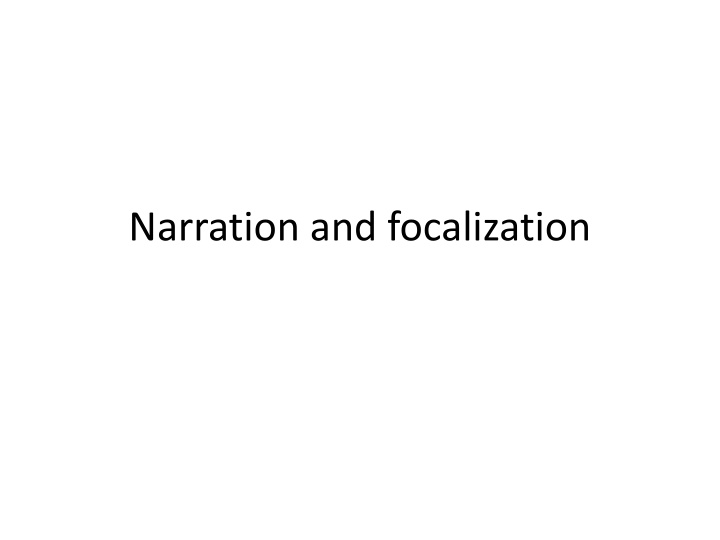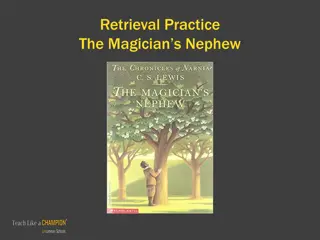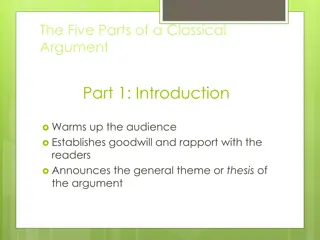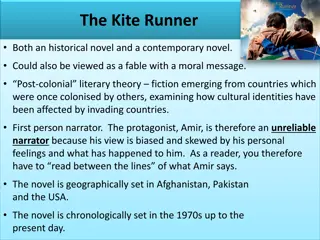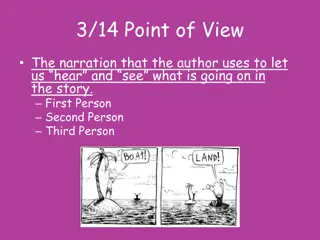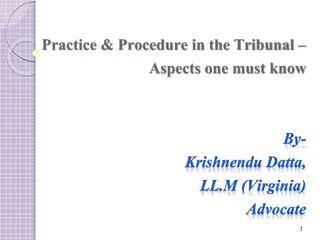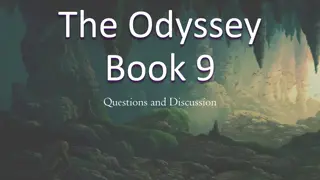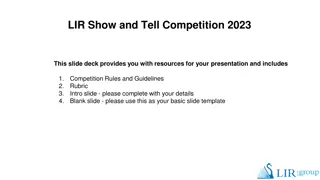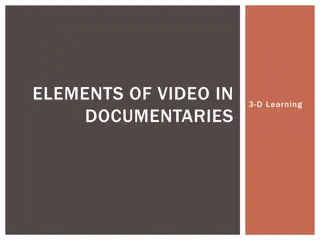Narration and Focalization
Unveil the intricate layers of narration and focalization in storytelling, delving into the impact of the narrator on the story's perception. From the nuances of narration in literature to the complexities of narration in audiovisual content, uncover the diverse facets that shape the fictional world and characters' experiences. Understand the roles of homodiegetic and heterodiegetic narrators, overt and covert narration, and the concept of diegesis. Dive into the world of storytelling levels in literature and film, unraveling the art of narrative composition and perspective.
Download Presentation

Please find below an Image/Link to download the presentation.
The content on the website is provided AS IS for your information and personal use only. It may not be sold, licensed, or shared on other websites without obtaining consent from the author.If you encounter any issues during the download, it is possible that the publisher has removed the file from their server.
You are allowed to download the files provided on this website for personal or commercial use, subject to the condition that they are used lawfully. All files are the property of their respective owners.
The content on the website is provided AS IS for your information and personal use only. It may not be sold, licensed, or shared on other websites without obtaining consent from the author.
E N D
Presentation Transcript
Stories Stories don t just exist they must be told The telling affects the story and how it is experienced
Narration Narration is the telling of the story The narrator is the person (entity) who tells the story
Storytelling levels in literature Source: Jahn, Narratology
Narration in audiovisual texts However, in audiovisual content the concept of narration is more problematic than in literature There may be no single narrator Some say there is no narrator at all Others say that the auteur is the narrator (usually the director) Jahn: Filmic Composition Device [FCD]
An important piece of vocabulary The fictional world within which the characters live and act is know as the diegesis
Narration Narration can come from within the fictional world ( homodiegetic ) or outside the fictional world ( heterodiegetic ) Narration can be very obvious ( overt ) or may be hard to detect ( covert ) The narrator may take the viewpoint of a character, may present the views of several characters or may approach the story from a godlike view ( omniscience )
Homodiegetic narrative The homodiegetic narrative is delivered by a story character someone actively involved in the narrative. Usually, but not always, she uses the first-person pronoun in her address. She may be the protagonist or just a bit player, but she is somehow affecting or affected by the actions going on in the story.
The Wonder Years Inside Man Desperate Housewives
Homodiegetic narrator The author/auteur must decide which character will narrate. The perspective of the narrator influences what the audience member will see, hear and know about the plot, other characters, etc. Minor characters may have very limited knowledge The nature of the narrator will also affect the tone and emotional implications of the narrative
Limitations of homodiegetic narration she is subject to 'ordinary human limitations' . . . she is restricted to a personal and subjective point of view; she has no direct access to (or authority on) events she did not witness in person; she can't be in two places at the same time . . . and she has no way of knowing for certain what went on in the minds of other characters. Jahn, Narratology
Homodiegetic narrators The Lovely Bones Atonement Apocalypse Now Malcolm in the Middle Fight Club Rashomon Goodfellas The Usual Suspects Apocalypse Now A Clockwork Orange
Displacement of time Homodiegetic narrators often tell a story about things that they experienced some time in the past A common form of such narration gives an account of the narrator s earlier life The Wonder Years Stand By Me Titanic
Heterodiegetic narration Heterodiegetic narration comes from a narrator who is not a character in the story. Heterodiegetic narrators vary widely in their knowledge and perspective. They may be restricted to the perspective of a single person or may have omniscience boundless ability to know all there is to know about the plot, characters, setting, etc. in a story.
Heterodiegetic narrators News anchors Documentary voice- overs Commercials Scroll in Star Wars VO in Lord of the Rings Almost all Westerns The Lost Boys The Client The Graduate The Hulk Stranger than Fiction Lord of the Rings
Narrator personality The personality and characteristics of the narrator will affect the audience response to the narrative How serious is he? How authoritative is he? How normal is he? Some voices project certain traits VO Narrators can make a lot of money
Overtness How obvious (or overt) is the narration? An overt narrator is out in the open a focus of the audience member s attention. A hidden narrator is covert. An overt narrator makes the telling or construction of the story an important focus for the audience
Indicators of narration in audiovisual media In film, television, videogames, etc. five main indicators of narration are present: Voice over (VO) narration an off-camera voice speaks to the audience member More rarely, an onscreen narrator is present The point of view of the camera Intrusive visual effects Onscreen writing Much of the craft of traditional Hollywood style is in making the narration covert.
Overtness Overt narration News anchors Game show hosts Inside Man Extreme Makeover Covert narration Big Bang Theory CSI Miami But note visual effects The Client A History of Violence
Point of View Physical point of view: the position or angle from which the camera or a particular narrator or character observes an event or a scene Mental point of view: the perspective taken by a particular narrator or character in a story in seeing and hearing an even or scene, reflecting on an idea, creating a relationship between two or more things, or remembering events or dreams
Focalization Focalization refers to the viewpoint from which the story is told Usually the viewpoint of the narrator omniscient However, the viewpoint can be split from the narration The narrator (or FCD) can tell the story from a character s perspective
Three major types of POV (Jahn) View of narrator Homodiegetic first-person Heterodiegetic omniscient Narrator becomes covert and presents viewpoint of story character Internal focalization
Advantages of omniscience The viewer/reader can be made aware of things that are unknown to the characters plot, characters (and what they are thinking), setting, backstory The maniacal killer is right behind you, idiot! The position allows for evaluation of characters and their actions He got what he deserved He knew he would get caught that s why he did it
Advantages of omniscience The story can be more expansive it can include a much wider set of characters, motives, actions While he was doing this, she was doing that, and her friend was with her brother, etc.
Internal focalization The story can be told from the viewpoint of a character even if the narrator is heterodiegetic The narrator gets inside the head of that character, often relating their perceptions, fears, beliefs, etc. to the implied audience member.
Internal focalization One of the main effects of internal focalization is to attract attention to the mind of the reflector-character and away from the narrator and the process of narratorial mediation. (Jahn) The goal in this case is to draw attention to the story and not its telling
Representing focalization Focalization can be represented by subjective camerawork over-the-shoulder camera shots, shot-reverse shot representations of interactions among characters, focus on a character looking into the distance then turning to adopt the sightline of the looker, etc. Things that only one character can see may be presented to the audience Sixth Sense Internal thoughts may be represented by VO
Objective and subjective visualization Objective CSI Big Bang Theory NCIS Subjective A Beautiful Mind Gladiator Lord of the Rings Rashomon Wolfen The Fisher King
Shifting narration and focalization Narration and/or focalization can shift within a given text perhaps between omniscient and first-person or from one character to another. Commonly, narrative begins with character narration, then it shifts to omniscient heterodiegetic FCD Grey s Anatomy
Can You Trust the Narrator? Sometimes narrators can t be trusted. A narrator whose account you cannot trust is known as an unreliable narrator. Limited view/Limited access Self interest/Deception Personal perspective Mental instability
Unreliable narrators Rashomon The Usual Suspects A Clockwork Orange The Murder of Roger Aykroyd Goodfellas Fight Club Dexter A Beautiful Mind
Paralepsis (Jahn) An infraction caused by saying too much; a narrator assuming a competence he does not properly have; typically, a first-person narrator (or a historiographer) narrating what somebody else thought . . . or what happened when he was not present.
Paralipsis (Jahn) An infraction caused by omitting crucial information; saying too little; typically, an omniscient narrator pretending "not to know" what happened in her/his characters' minds, or what went on at the same time in another place, or distortively censoring a character's thought, or generally pretending to be restricted to ordinary human limitations.
Paralepsis and paralipsis are instances of violations of Grice's (1975) famous principle of co-operation -- the notion that speakers (narrators) are socially obliged to follow an established set of 'maxims': to give the right amount of information, to speak the truth, to speak to a purpose (tell something worth telling), to be relevant, etc.
Audiences will assume narrators are following the rules until it is demonstrated that they are not.
